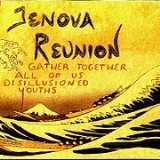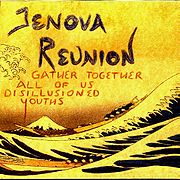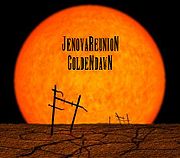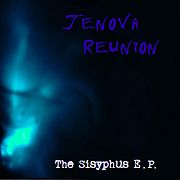
Jenova Reunion
Encyclopedia
Jenova Reunion is a progressive musical collective known for creating large narrative musical works in varying styles, ranging from classical guitar
, orchestral symphony
and piano
solos to psychedelic rock
, electro and noise music
, often blending many of these genres and styles together to create a unique musical soundscape. The collective takes its name from a major event in the storyline of the video game Final Fantasy VII
.
Jenova Reunion is often loath to play live, since many of its musical pieces contain multitracking
, musique concrète
and various studio effects that are almost impossible to replicate in a live venue.
Much of Jenova Reunion's music is created using sequencers
and synthesisers to replicate the sounds of instruments not readily available, or indeed create new sounds from scratch.
Jenova Reunion has three albums completed to date, though none have yet been released by a record label
: they have been distributed by Jenova Reunion itself.
All of Jenova Reunion's albums are "concept albums," with science fiction
-influenced narratives and escapist themes.
 Jenova Reunion's first album was a collection of instrumental
Jenova Reunion's first album was a collection of instrumental
and noise tracks, linked by a loose framing narrative
of various characters seeking escape from their respective worlds.
The album is split into three "chapters
," chapter one being dreams of escape, chapter two the act of escape and chapter three the results. The three chapters are linked by short "interludes
," synthesised noise pieces, and the album both opens and closes with similar short noise pieces.
Tracklisting
(All tracks by Jenova Reunion)
The symbols
used to denote the interludes are used in Arabic calligraphy
to signify the end of a chapter or paragraph.
Track 2 contains samples of a Klingon
drinking song and a radio interview with Jared Leto
.
Track 14's title is a reference to Canadian post-rock
band Godspeed You! Black Emperor
, taken from the opening monologue of their album f♯a♯∞
.
 Jenova Reunion's second album took a more sweeping, symphonic turn, with tracks linking together so that the album seems like one continuous piece of music. As with Gather Together, this album has a loose narrative framework, telling the story of the creation of a planet, life flourishing on it and dying, and finally the death of the planet's sun, leaving the desolate world to float silently and coldly into space.
Jenova Reunion's second album took a more sweeping, symphonic turn, with tracks linking together so that the album seems like one continuous piece of music. As with Gather Together, this album has a loose narrative framework, telling the story of the creation of a planet, life flourishing on it and dying, and finally the death of the planet's sun, leaving the desolate world to float silently and coldly into space.
Tracklisting
(All tracks by Jenova Reunion)
The album is linked throughout by a recurring sound, which both opens and closes the album, and is to be heard (though often barely audible) in many of the tracks. This sound represents the cycle of the album, of the death and rebirth inherent in nature and occurs in the album during moments describing major creation or destruction.
Tracks 1 and 9 contain samples from the film Blade Runner
, tracks 2 and 6 contain samples from Easy Rider
, and track 3 contains a sample from the film Event Horizon
.
The title of track 3 is taken from John Milton
's epic poem Paradise Lost
:
Track 6's title is a portmanteau of T. S. Eliot
's poem The Hollow Men
and its epigraph, "A penny for the Old Guy," and track 9's title is derived from the closing lines of this poem:
Similar to Gather Together, Golden Dawn is also divided into three distinct sections, or "acts
," divided on the album by breaks in musical continuity. Tracks 1, 2 and 3 comprise act one, in which the planet is created and shaped by violent geological and astronomical events. Act two consists of tracks 4, 5 and 6, in which the planet forms an atmosphere and begins to support life, which flourishes briefly, then dies. The final act (tracks 7, 8 and 9) charts the final days of the planet as its sun slowly dies, then sets for the last time. The final track samples Roy Batty's dying monologue from Blade Runner, as though it were the planet speaking.
 Jenova Reunion has recently released The Sisyphus EP, which it calls "an experiment in multitracked synthesis."
Jenova Reunion has recently released The Sisyphus EP, which it calls "an experiment in multitracked synthesis."
Tracklisting
(All tracks by Jenova Reunion)
Side one is Sisyphus, which uses recordings of police radio
and number stations. Side two is 1866 (The Symphony of Space) which is entirely instrumental.
The EP is named for the Greek mythological figure Sisyphus
, and 1866 (The Symphony of Space) refers to the asteroid 1866 Sisyphus
.
by Erich von Däniken
. It is concerned with the story of a traveller who arrives on Earth from a far-off world and influences human civilizations and technology, while slowly going mad from loneliness and isolation from both humans and his own people.
Tracklisting
(All tracks by Jenova Reunion)
Part I
Part II
Each track is named after a significant work of science fiction literature, in keeping with the album's science fiction-inspired plot.
Tracklisting
Classical guitar
The classical guitar is a 6-stringed plucked string instrument from the family of instruments called chordophones...
, orchestral symphony
Symphony
A symphony is an extended musical composition in Western classical music, scored almost always for orchestra. A symphony usually contains at least one movement or episode composed according to the sonata principle...
and piano
Piano
The piano is a musical instrument played by means of a keyboard. It is one of the most popular instruments in the world. Widely used in classical and jazz music for solo performances, ensemble use, chamber music and accompaniment, the piano is also very popular as an aid to composing and rehearsal...
solos to psychedelic rock
Psychedelic rock
Psychedelic rock is a style of rock music that is inspired or influenced by psychedelic culture and attempts to replicate and enhance the mind-altering experiences of psychedelic drugs. It emerged during the mid 1960s among folk rock and blues rock bands in United States and the United Kingdom...
, electro and noise music
Noise music
Noise music is a term used to describe varieties of avant-garde music and sound art that may use elements such as cacophony, dissonance, atonality, noise, indeterminacy, and repetition in their realization. Noise music can feature distortion, various types of acoustically or electronically...
, often blending many of these genres and styles together to create a unique musical soundscape. The collective takes its name from a major event in the storyline of the video game Final Fantasy VII
Final Fantasy VII
is a role-playing video game developed by Square and published by Sony Computer Entertainment as the seventh installment in the Final Fantasy series. It was originally released in 1997 for the Sony PlayStation and was re-released in 1998 for Microsoft Windows-based personal computers and in 2009...
.
Jenova Reunion is often loath to play live, since many of its musical pieces contain multitracking
Multitrack recording
Multitrack recording is a method of sound recording that allows for the separate recording of multiple sound sources to create a cohesive whole...
, musique concrète
Musique concrète
Musique concrète is a form of electroacoustic music that utilises acousmatic sound as a compositional resource. The compositional material is not restricted to the inclusion of sounds derived from musical instruments or voices, nor to elements traditionally thought of as "musical"...
and various studio effects that are almost impossible to replicate in a live venue.
Much of Jenova Reunion's music is created using sequencers
Music sequencer
The music sequencer is a device or computer software to record, edit, play back the music, by handling note and performance information in several forms, typically :...
and synthesisers to replicate the sounds of instruments not readily available, or indeed create new sounds from scratch.
Jenova Reunion has three albums completed to date, though none have yet been released by a record label
Record label
In the music industry, a record label is a brand and a trademark associated with the marketing of music recordings and music videos. Most commonly, a record label is the company that manages such brands and trademarks, coordinates the production, manufacture, distribution, marketing and promotion,...
: they have been distributed by Jenova Reunion itself.
All of Jenova Reunion's albums are "concept albums," with science fiction
Science fiction
Science fiction is a genre of fiction dealing with imaginary but more or less plausible content such as future settings, futuristic science and technology, space travel, aliens, and paranormal abilities...
-influenced narratives and escapist themes.
Gather Together All of Us Disillusioned Youths (2007)

Instrumental
An instrumental is a musical composition or recording without lyrics or singing, although it might include some non-articulate vocal input; the music is primarily or exclusively produced by musical instruments....
and noise tracks, linked by a loose framing narrative
Narrative
A narrative is a constructive format that describes a sequence of non-fictional or fictional events. The word derives from the Latin verb narrare, "to recount", and is related to the adjective gnarus, "knowing" or "skilled"...
of various characters seeking escape from their respective worlds.
The album is split into three "chapters
Chapter (books)
A chapter is one of the main divisions of a piece of writing of relative length, such as a book. Chapters can be numbered in the case of such writings as law code or they can be titled. For example, the first chapters of some well-known novels are titled:*"The Boy Who Lived" – Harry Potter...
," chapter one being dreams of escape, chapter two the act of escape and chapter three the results. The three chapters are linked by short "interludes
Bridge (music)
In music, especially western popular music, a bridge is a contrasting section which also prepares for the return of the original material section...
," synthesised noise pieces, and the album both opens and closes with similar short noise pieces.
Tracklisting
(All tracks by Jenova Reunion)
- "Who Are You?" – 0:37
- "Annie Dreams of Another World...." – 9:37
- "Second Star to the Right" – 2:04
- "Interlude ۞ Fucked Radio Signal" – 0:30
- "Amplitude Shift" – 2:28
- "Jimi Hendrix Industrial Standards" – 4:40
- "Into the Dragon's Lair" – 3:25
- "Escape from Electric Palace" – 4:47
- "Quraish" – 2:53
- "C20H25N3O (Transmetropolitan Airwaves)" – 6:55
- "Interlude ۞ Modulated Saw" – 1:13
- "Indiscreet Lenses" – 12:25
- "First Edition" – 7:16
- "The Machine Is Bleeding to Death" – 0:37
The symbols
Rub El Hizb
The Rub el Hizb is a Muslim symbol, represented as two overlapping squares, which is found on a number of emblems and flags. In Arabic, Rubʻ means "one fourth, quarter", while Hizb means a group or party...
used to denote the interludes are used in Arabic calligraphy
Calligraphy
Calligraphy is a type of visual art. It is often called the art of fancy lettering . A contemporary definition of calligraphic practice is "the art of giving form to signs in an expressive, harmonious and skillful manner"...
to signify the end of a chapter or paragraph.
Track 2 contains samples of a Klingon
Klingon
Klingons are a fictional warrior race in the Star Trek universe.Klingons are recurring villains in the 1960s television show Star Trek: The Original Series, and have appeared in all five spin-off series and eight feature films...
drinking song and a radio interview with Jared Leto
Jared Leto
Jared Joseph Leto is an American actor, director, producer, occasional model and musician. Leto has appeared in both big budget Hollywood films and smaller projects from independent producers and art houses. He rose to prominence for playing Jordan Catalano in the teenage drama My So-Called Life...
.
Track 14's title is a reference to Canadian post-rock
Post-rock
Post-rock is a subgenre of rock music characterized by the influence and use of instruments commonly associated with rock, but using rhythms and "guitars as facilitators of timbre and textures" not traditionally found in rock...
band Godspeed You! Black Emperor
Godspeed You! Black Emperor
Godspeed You! Black Emperor is a Canadian post-rock band which originated from Montreal, Quebec in 1994...
, taken from the opening monologue of their album f♯a♯∞
F♯A♯∞
F♯ A♯ ∞ is the debut album of the Canadian post-rock band Godspeed You! Black Emperor. It was released twice, first in 1997 by Constellation Records and then again on 8 June 1998, by Kranky as an expanded edition that ran for 63:27...
.
Golden Dawn (2007)

Tracklisting
(All tracks by Jenova Reunion)
- "Golden Dawn Overture" - 11:40
- "Without Form, and Void" - 11:50
- "Better to Reign in Hell" - 1:47
- "Taking a Planet's First Breath" - 5:52
- "Once More She Conceives" - 3:14
- "A Penny for the Old Hollow Men" - 8:47
- "Solstice, and the Sky Bleeds Gold" - 1:31
- "Last Rays of Our Dying Sun" - 6:05
- "This is the Way the World Ends" - 1:14
The album is linked throughout by a recurring sound, which both opens and closes the album, and is to be heard (though often barely audible) in many of the tracks. This sound represents the cycle of the album, of the death and rebirth inherent in nature and occurs in the album during moments describing major creation or destruction.
Tracks 1 and 9 contain samples from the film Blade Runner
Blade Runner
Blade Runner is a 1982 American science fiction film directed by Ridley Scott and starring Harrison Ford, Rutger Hauer, and Sean Young. The screenplay, written by Hampton Fancher and David Peoples, is loosely based on the novel Do Androids Dream of Electric Sheep? by Philip K...
, tracks 2 and 6 contain samples from Easy Rider
Easy Rider
Easy Rider is a 1969 American road movie written by Peter Fonda, Dennis Hopper, and Terry Southern, produced by Fonda and directed by Hopper. It tells the story of two bikers who travel through the American Southwest and South with the aim of achieving freedom...
, and track 3 contains a sample from the film Event Horizon
Event Horizon (film)
Event Horizon is a 1997 science fantasy horror film. The screenplay was written by Philip Eisner and directed by Paul W. S. Anderson. The film stars Laurence Fishburne and Sam Neill...
.
The title of track 3 is taken from John Milton
John Milton
John Milton was an English poet, polemicist, a scholarly man of letters, and a civil servant for the Commonwealth of England under Oliver Cromwell...
's epic poem Paradise Lost
Paradise Lost
Paradise Lost is an epic poem in blank verse by the 17th-century English poet John Milton. It was originally published in 1667 in ten books, with a total of over ten thousand individual lines of verse...
:
- Here we may reign secure, and in my choyce
- To reign is worth ambition though in Hell:
- Better to reign in Hell, then serve in Heav'n
Track 6's title is a portmanteau of T. S. Eliot
T. S. Eliot
Thomas Stearns "T. S." Eliot OM was a playwright, literary critic, and arguably the most important English-language poet of the 20th century. Although he was born an American he moved to the United Kingdom in 1914 and was naturalised as a British subject in 1927 at age 39.The poem that made his...
's poem The Hollow Men
The Hollow Men
The Hollow Men is a major poem by T. S. Eliot. Its themes are, like many of Eliot's poems, overlapping and fragmentary, but it is recognised to be concerned most with post-World War I Europe under the Treaty of Versailles , the difficulty of hope and religious conversion, and, as some critics...
and its epigraph, "A penny for the Old Guy," and track 9's title is derived from the closing lines of this poem:
- This is the way the world ends
- This is the way the world ends
- This is the way the world ends
- Not with a bang but a whimper.
Similar to Gather Together, Golden Dawn is also divided into three distinct sections, or "acts
Act (theater)
An act is a division or unit of a drama. The number of acts in a production can range from one to five or more, depending on how a writer structures the outline of the story...
," divided on the album by breaks in musical continuity. Tracks 1, 2 and 3 comprise act one, in which the planet is created and shaped by violent geological and astronomical events. Act two consists of tracks 4, 5 and 6, in which the planet forms an atmosphere and begins to support life, which flourishes briefly, then dies. The final act (tracks 7, 8 and 9) charts the final days of the planet as its sun slowly dies, then sets for the last time. The final track samples Roy Batty's dying monologue from Blade Runner, as though it were the planet speaking.
The Sisyphus E.P. (2008)

Tracklisting
(All tracks by Jenova Reunion)
- "Sisyphus"
- "1866 (The Symphony of Space)"
Side one is Sisyphus, which uses recordings of police radio
Police radio
Police radio is a communications radio system used by law enforcement agencies all over the world.Many such systems are encrypted to prevent eavesdroppers from listening in.-Portable radios:...
and number stations. Side two is 1866 (The Symphony of Space) which is entirely instrumental.
The EP is named for the Greek mythological figure Sisyphus
Sisyphus
In Greek mythology Sisyphus was a king punished by being compelled to roll an immense boulder up a hill, only to watch it roll back down, and to repeat this throughout eternity...
, and 1866 (The Symphony of Space) refers to the asteroid 1866 Sisyphus
1866 Sisyphus
1866 Sisyphus is a binary Apollo asteroid which, at approximately 10 km in diameter, is the largest of the Earth-crossing asteroids. It is comparable in size to the Chicxulub object whose impact may have killed off the dinosaurs....
.
Chariots of the Gods (2008)
Jenova Reunion's third album is a double album called Chariots of the Gods, after the bookChariots of the Gods
Chariots of the Gods? Unsolved Mysteries of the Past is a book written in 1968 by Erich von Däniken...
by Erich von Däniken
Erich von Däniken
Erich Anton Paul von Däniken is a Swiss author best known for his controversial claims about extraterrestrial influences on early human culture, in books such as Chariots of the Gods?, published in 1968...
. It is concerned with the story of a traveller who arrives on Earth from a far-off world and influences human civilizations and technology, while slowly going mad from loneliness and isolation from both humans and his own people.
Tracklisting
(All tracks by Jenova Reunion)
Part I
- "Chariots of the Gods" - 7:08
- "Stranger in a Strange Land" - 3:56
- "At the Mountains of Madness" - 4:15
- "The Invisible Man" - 9:28
- "Brave New World" - 4:51
- "City on the Edge of Forever" - 5:16
- "The Man in the High Castle" - 6:02
Part II
- "Beyond the Infinite" - 20:37
- "Eye in the Sky" - 4:23
- "The Inner Light" - 7:46
- "We" - 2:28
- "Century Rain" - 5:24
- "Chariots of the Gods?" - 3:04
Each track is named after a significant work of science fiction literature, in keeping with the album's science fiction-inspired plot.
- "Part one of the double album is told from the perspective of the alien astronaut as he travels the vast distances from his home planet, landing on Earth at the dawn of man to find himself the only intelligent being on the planet. In his loneliness, he gradually goes insane. He begins to interfere with and influence human affairs and history as the species evolves, eventually setting himself up, in his growing madness, as a god of humanity.
- "Part two opens with a signal crossing the endless void of space. The signal reaches Earth, and the astronaut receives a message from his people, who have discovered the horrendous mess he has made on Earth, and ordered him home. The album concludes with the astronaut trying to leave Earth as inconspicuously as possible, but failing and causing massive social and cultural upheaval. He embarks on the long journey home, penitent, lonely and reviled."
The Man in the High Castle
Jenova Reunion has released The Man in the High Castle as a single, with a slightly different edit. The Theme from Space Hospital was released as the b-side.Century Rain / Potsdamer Platz
Century Rain was released as the second single from Chariots of the Gods. It was released as a double A-side with Potsdamer Platz, the lead single from Jenova Reunion's upcoming album Cats Among the Rubble.Cats Among the Rubble (2009)
The fourth Jenova Reunion album moves in a less experimental direction, focusing instead on musical and tonal coherence.Tracklisting
- "Time's Incisor / The Red Granite Colossus" - 5:39
- "A Hope for the Future (and for the Past)" - 5:19
- "Festival of the Wolf / The Godking's Tomb" - 5:22
- "Potsdamer Platz (Thermonuclear Dreams)" - 4:09
- "Pyramid in the Sand / Lost to the Winds" - 3:11
- "There Is a City (A Wall Behind the Ocean)" - 2:35
- "Within Flesh & In Our Blood / Cassiopeia" - 5:19
- "Echoes of a Dead King (Babylon Is Fallen)" - 6:04
- "Métropole de Lumiere / Nothing Ever Ends" - 9:35

